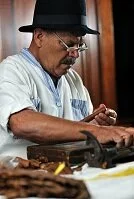
Cigar maker
However, not everyone has abandoned the rural lands as nearly 20% of the people work in agriculture. For these people life is dictated by the sun, the seasons, and the weather, but also by the government. The government makes sure everyone in the country is fed and this begins with local farmers who can be greatly supported by the government if needed.
No matter where a person lives, the people are highly educated and this remains among the most important aspects of the culture and is the center of daily life for many with children. Since school, lunches, and day care are all available free of charge, many schools are open from about 6:30 am to about 6:30 pm, acting as both a school as well as a day care for children whose parents have to work early or late.
Education follows through the university level and today there is a massive growth in the number of professional post-graduate schools in Cuba. This is also leading to a more educated society and today there is a significant number of professionals in the country, such as physicians.
More than just schedule, education, and politics, the way of life in Cuba is about society. Granted this stems from government-imposed socialism, but many people have a mentality that one should help others so the people are quite giving. Work and education are undertaken to benefit one's self and one's family, but also to benefit society as a whole as this is the center of life in Cuba for many Cubans.
Identity
To be Cuban is to be an ideal in the minds of the people, an ideal the current government is arguably trying to accomplish. In the early 1900s the island was divided in nearly every way, but in the late 1800s and into today there has been a slow movement to create this ideal (although it sped up in 1959 when the communists took over). The Cubans in Cuba define themselves by this ideal, which seeks equality among all people no matter their color, race, ethnicity, economic standing, or education. It is defined, in many ways, by claiming there is no difference between people as all are equals. This movement began with the fight against slavery and today continues in an attempt to create economic uniformity through communist policies. Although the politic situation hasn't created the ideal that is strived for, the identity is still defined by ideals, not by ethnicity, language, politics, or wealth. To be Cuban is to be a person who sees all as equals and who wishes for all to be equals in every definition; it is also secondly defined in political and ethnic terms.
It is important to note that to most ethnic Cubans abroad, who also identify as "Cuban," define this identity primarily in terms of ethnicity, the Spanish language, the Catholic faith, the food, the music, and the culture.